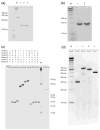Six-helix and eight-helix DNA nanotubes assembled from half-tubes
- PMID: 17500580
- PMCID: PMC2527457
- DOI: 10.1021/nl070828k
Six-helix and eight-helix DNA nanotubes assembled from half-tubes
Abstract
DNA nanotubes are cylinder-like structures formed from DNA double-helical molecules whose helix axes are fused at least twice by crossovers. It is potentially useful to use such tubes as sheaths around rodlike species that arise in biological systems and in nanotechnology. It seems easiest to obtain such sheathing by joining two or more components around an object rather than attempting to thread the object through a cavity in the tube. We report two examples of tubes containing a specific number of helices that are assembled from half-tube components. These tubes are a six-helix bundle and an eight-helix bundle, constructed respectively from two bent triple-crossover (BTX) molecules and from two four-helix arched motifs. Both species contain single strands in one molecule that are missing in its mate. The six-helix bundle is formed from two different BTX molecules, whereas the eight-helix species is a closed cyclic dimer of the same molecule. We demonstrate the formation of these species by gel electrophoresis, and we examine their arrangement into long one-dimensional arrays by means of atomic force microscopy.
Figures





References
Publication types
MeSH terms
Substances
Grants and funding
LinkOut - more resources
Full Text Sources
Other Literature Sources

